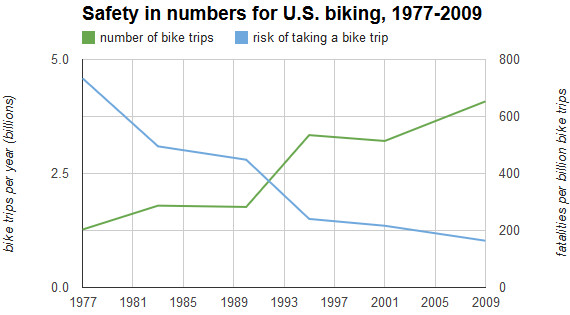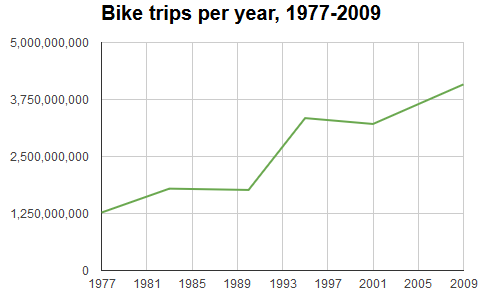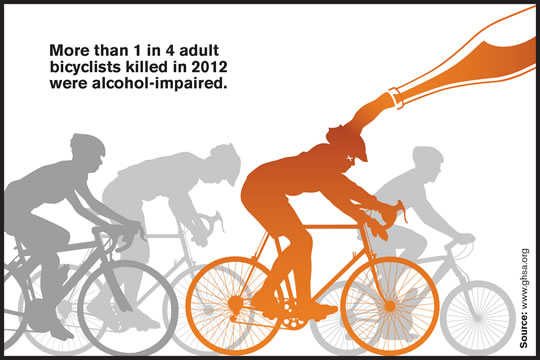
The Governors Highway Safety Association released a report Monday that, the organization claimed, showed that the ongoing surge in American biking has increased bike fatalities.
Transportation reporters around the country swung into action.
"Fatal bicycle crashes on the rise, new study shows," said the Des Moines Register headline.
"Cycling is increasing and that may be reflected by an increase in fatal crashes," wrote NJ.com.
"Bike riding, particularly among urban commuters, is up, and the trend has led to a 16 percent increase in cyclist fatalities nationwide," reported the Washington Post.
Bike fatalities are a serious problem that needs to be tackled. The United States has dramatically higher rates of injury and death on bikes than other rich countries, and it would be appropriate for GHSA, an umbrella organization of state departments of transportation, to issue an urgent call to action to make biking safer. So it's especially troubling that the main thrust of this report is complete baloney.
As dedicated bike infrastructure has boosted U.S. ridership, risk has plummeted 78 percent

It's true that the number of bike fatalities nationwide has increased over the last two years, from 621 in 2010 to 722 in 2012 -- thus the bizarre infographics and hysterical headlines about the "growing problem" of bike fatalities. Buried deep in the report, though, GHSA notes that the annual death rate of cyclists is actually "among the lowest since 1975," when U.S. DOT's Fatality Analysis Reporting System first started compiling this data:
The highest annual total (1,003) occurred in 1975. Yearly deaths averaged 933 from 1975 to 1979, 889 in the 1980s, 792 in the 1990s, and 696 from 2000 to 2012. The 621 deaths in 2010 were the lowest in the 38 years of FARS.
But yes, between 2010 and 2012, the number of bike fatalities did increase. And that's because the total number of bike trips in the country has been soaring:
Put those figures together, and what's actually happening is that for an infinitesimal fraction of the cost of the nation's transportation system, Americans are enjoying billions more bike trips every year than they were a generation ago. And because the sheer number of bikes on the street is teaching drivers to keep an eye out for bikes, every single bike trip is far, far safer than it was.
GHSA calls out six states for having the highest rate of bike deaths -- California, Florida, Illinois, New York, Michigan, and Texas, which together accounted for 54 percent of all bicyclist deaths in collisions with motorists -- without mentioning that those also happen to be the highest-population states in the country. The authors don't even try to distinguish between places that are particularly dangerous for bicyclists and places where there are simply a lot of bikes on the street -- possibly because it's a particularly safe place to ride.
GHSA returns to its default stance: blaming the victim
Frustratingly, in its report calling attention to the "growing problem" of bicyclist fatalities, GHSA thrusts the responsibility back on the bicyclist. "Lack of helmet use and alcohol impairment have been and continue to be major contributing factors in bicyclist deaths," says the report.
GHSA doesn't devote much ink to street design or safe infrastructure. The report doesn't mention the dangers of fast-moving car traffic on wide roads. It doesn't endorse Vision Zero.
Instead, while admitting that "total physical separation [between bicycles and motor vehicles] is preferable," GHSA dismisses it as "rarely feasible." Bike lanes, bicycle boulevards, bicycle signals, traffic calming, and roadway lighting get one offhanded mention, while helmet use and alcohol get weird infographics -- see above.
The victim-blaming is par for the course for GHSA, which made waves in 2011 when it implied that First Lady Michelle Obama's Let's Move program had catalyzed an uptick in pedestrian deaths over a six-month period. GHSA didn't exactly say the FLOTUS herself had pedestrians' blood on her hands for inspiring more people to get out walking, but that's how the news was reported. What the organization really meant to say, GHSA's director clarified later, was that it was pedestrians' fault for listening to their iPods.
Even so, GHSA says bike safety doesn't merit national attention

Meanwhile, somewhat confusingly, GHSA has been holding forth on Twitter that bike fatalities are unimportant.
Yesterday -- the same day it released a national report calling attention to the issue -- the organization tweeted that these deaths don't require national attention:
Unlike many hwy safety issues, bike fatalities impact only a few states. Not an issue req nat'l attn. http://t.co/HOP99vXgG6 #GHSAbike
— GHSA (@GHSAHQ) October 27, 2014
In another tweet, GHSA declared that bike-related fatalities aren't an issue worth "universal" concern because only "specific groups" of Americans are being killed:
REPORT: Bike fatalities are a growing problem for specific groups, but not an issue universally. http://t.co/shZZsLYmuO #GHSABike
— GHSA (@GHSAHQ) October 27, 2014
Reporters and editors treat the GHSA with respect because it describes itself as "The States' Voice on Highway Safety." State officials who are interested in helping their residents safely enjoy the benefits of biking might want to consider whether, on this issue, the GHSA is actually speaking for them.
Michael Andersen blogs for The Green Lane Project, a PeopleForBikes program that helps U.S. cities build better bike lanes to create low-stress streets. You can follow The Green Lane Project on Twitter or Facebook or sign up for its weekly news digest about protected bike lanes.







